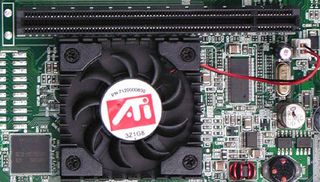The Athlon64 Radeon Xpress: ATi's Latest Stab as a Chipset Maker
Radeon Xpress 200 Graphics

Running at 350 MHz core clock, ATi's Radeon Xpress 200 should be actively ventilated.
Based on the Radeon X300 core, the graphics unit of the Radeon Xpress 200 is fully DirectX 9 compliant, offering Pixel and Vertex Shader 2.0 support. Two pixel pipelines with one texture unit each and four vertex shaders per pipeline are adequate for an integrated graphics solution.
The core clock of our test system was 350 MHz, while we did not find out how fast the local frame buffer memory was running. What we do know is that this local memory is attached via a 32 bit interface. The BIOS of the reference motherboard allows for selecting an interleaved 2x32 mode, but this one caused the system to lock up.
HyperMemory

HyperMemory is ATi's buzzword for describing the flexibility provided by the graphics unit. Motherboard makers can setup Radeon Xpress 200 as a regular UMA solution, using parts the system's dual channel DDR400 memory as frame buffer. Alternatively, a dedicated local frame buffer can be deployed in Radeon Xpress 200 systems, providing quicker local memory access and faster bandwidth. Our benchmark section details the resulting performance.
Performance Considerations
Although the integrated graphics engine runs at 350 MHz, it won't be fast enough, of course, to beat any conventional PCIe graphics board that runs current technology, due to memory bottlenecks. This is why ATi decided to pick the relatively low number "200" in the Radeon Xpress 200's name, since the graphic engine's performance will not be good enough to even beat the Radeon X300.
Stay on the Cutting Edge
Join the experts who read Tom's Hardware for the inside track on enthusiast PC tech news — and have for over 25 years. We'll send breaking news and in-depth reviews of CPUs, GPUs, AI, maker hardware and more straight to your inbox.
Current page: Radeon Xpress 200 Graphics
Prev Page Radeon Xpress 200P, Radeon Xpress 200 Next Page PCIe Graphics Upgrade Option Or Multi-Monitor SupportMost Popular

